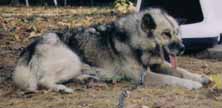
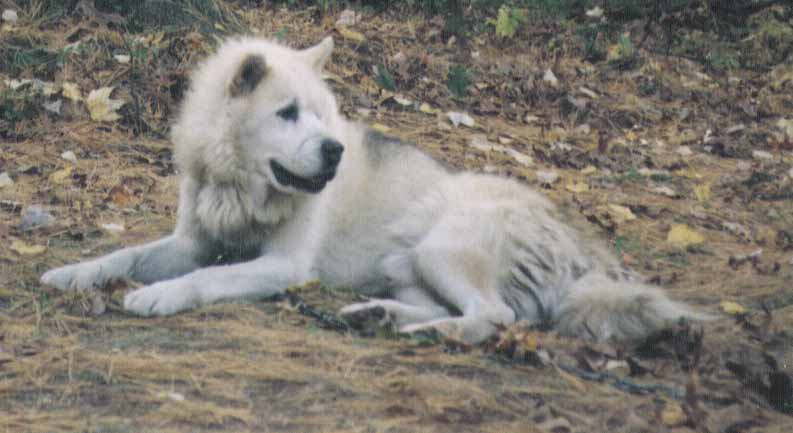

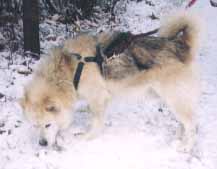
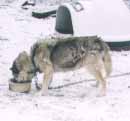
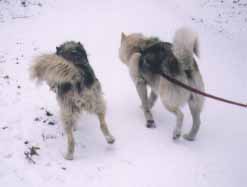






There is only one Mawson husky left at Outward Bound, Misty. Later in January Betty visited Outward Bound and saw Misty, who is now retired. We considered asking for Misty, but we knew Zoya would not get along with her. Zoya fights with almost any dog in the neighborhood who gets close to her. Once a very small dog ran across the street and tried to bite her in the face. Instead, he ended up in Zoya's mouth, even though I had her on a leash. Finally he got away and ran home. We don't let Zoya off the leash. (Zoya is no problem with people; she thinks all humans are wonderful.)
Shortly before we lost Bundy, we found a growth in Tom's mouth. The vet removed the growth and the biopsy showed it was a very malignant melanoma. Only a few weeks after it was removed, it grew back and was causing a great deal of pain to Tom. Towards the end of April, with the advice of our vet, we said goodbye to Tom. He had been very lively and energetic and a wonderful walking companion. It was hard to let him go.
This winter is fantastic, speaking as a winter person. We have had snow on the ground since Christmas. Every week we get one or two new snowfalls of 4 to 6 inches and it's been mostly too cold for the snow to melt. So we have plenty of lovely snow. Last night we got another storm and this morning we let Zipper break trail. He seems to really enjoy bounding through the snowdrifts. Bundy finds the snow a little difficult for walking. However, she has trained us to feed her while she rests and stays warm in her kennel.
Zipper is young and hale and hardy at only 11 years of age (will be 12 in March 2001). We are still taking relatively long walks with him. This afternoon, I walked with him to a pond about a mile away and walked a little around it. The sun is setting around 4pm, and we walked from about 3:15 to 4. It was lovely around the pond, and Zipper trotted along jauntily, leaving little scented reminders here and there.
On Thursday, April 27, 2000 Arne was put to sleep. He was thirteen and a half years old. His ability to walk had rapidly diminished since November until he could not stand up at all. We used increasingly strong painkillers to help him, but eventually Arne himself let us know what he wanted. We miss him.
Also, Morrie, one of the older Mawson huskies, who was shipped to Melbourne Australia in 1993 because he was too old to be sent to Minnesota died on February 4, 2000. He was fourteen and a half years old. He is survived by his litter-mate, Ursa. See Vale Morrie.
Bundy's son Zipper has been retired from Voyager Outward Bound and is now living with us. He arrived on April 15, and we picked him up at the NorthWest freight terminal in the evening. He was very happy to get out of the extra large kennel that he travelled in, and take a good run (attached to Betty)outside the terminal. On the way home he sat in the back of our hatchback and regarded the sights of Boston. When Zipper arrived at his new home, Arne made it quite clear (from the garage) that he wanted nothing to do with Zipper, while Bundy sniffed him briefly, recognised him and then ignored him. He has settled in well, and is providing company for Bundy, who mostly ignores him.
Arne and Bundy were born in November 1986, so now they are 13. They have been with us for over a year now. Bundy is very energetic still, but Arne is having trouble with his arthritis, so he tires early on our walks. But he always wants to go and enjoys puttering around.
It is getting (nov 30) to be good husky weather. We may have snow tomorrow and there was ice in the dogs' water bowls this morning and frost on the wetlands near our house. In this season, Arne and Bundy get soup (made with table left-overs and water heated up). Soup today was turkey, left from the thanksgiving feast, with lots of nice turkey skin and a little meat. This supplements their dogfood, and mainly hydrates them. They drink every last drop and clearly love it.
We made several dog-related visits last summer. Lawrence visited Melbourne where he met Io, a daughter of Bundy, and Morrie and Ursa. Morris and Ursa are now 14 years old.
Betty went to Outward Bound in Minnesota in August to visit Pearl and Brett and also visited many of the mates of Bundy and Arne in the dogyard. SueEllen was in charge of the dogs and made the introductions. Still at Outward Bound are Zipper (son of Bundy), Tom (grandson of Bundy; son of Zipper) Plato and Groo (sons of Io, grandsons of Bundy) and Misty and Frosty. Tom has fathered two new pups, Havoc and Burlap, great-grandchildren of Bundy. The following Mawson dogs have died: Cardiff, Luvan, Bear, Kirsty, Thunder, Sprocket, Cobber, and Lobo. Four died of an unknown illness, three of "bloat" and Cobber died in an accident.
Information relayed to us from Wintergreen Lodge: Cocoa and Goohaw are still alive. Jedda died shortly after arrival. Merlin and Oscar died of old age.
We have also obtained some antarctic paintings from Lucia Deleiris , who visited there under the (U.S.) NSF artists program. Lucia lives in Massachusetts.
Just last week we went to a weekend of "snow walkers" where there were many mushers from the U.S. and Canada. We learned about how to make an igloo, how to tell if ice is safe to walk on, how to put up a wall tent, what plants grow in the arctic....so we are becoming very good armchair explorers.
The favorite summer trip is down to a little pond where Arne and Bundy can eat mud-covered plant roots. Bundy likes to get pretty wet and would prefer to catch a frog, but the frogs are too fast. Arne just eats mud with roots. Afterwards, they lick the mud off their feet while resting. When it gets very hot (over about 20 degrees Celsius or 68 Fahrenheit), we don't take them for a walk at all. But it is often cooler in the mornings, so today we even went for a two-mile walk to a playground. Still the highlight is the pool with the mud.
Every morning and every evening Arne and Bundy's Australian and American handlers take them for a walk. After the walk, they are fed. The rest of the time, they mostly sleep in their doghouses, or, if it is sunny, they lie down outside on the ground.
2. How is their health?
Both Bundy and Arne are pretty healthy. Both dogs have arthritis, which is being treated by aspirin. Both huskies have cataracts. There are no apparent other problems. They have a seen a local vet for an initial visit and examination and Bundy went back when her arthritis was giving her pain. They have had vaccinations and worm pills as needed. They get ticks in our neighborhood and get medicine to kill the ticks.
3. How did they get to Massachusetts? (and why?)
Bundy and Arne are staying with the mother and stepfather of Pearl Stark, a dogger (U.S., Canadian: "musher") in the Voyageur Outward Bound School. Pearl and her friend Brett Yost, another dogger, brought Bundy and Arne by car from Minnesota to Massachusetts. Pearl's stepfather, Lawrence Morris, is an Australian, having been brought up on a dairy farm in Western Australia near Albany. His parents now live in Orange, NSW. The Australian connection probably helped.
4. What is a typical walk like?
Bundy and Arne like to sniff around at scents left by other animals. They like to walk in the evenings better than the mornings, so that is when they get their longer walk of about three miles. In the morning they get a short walk. They are usually interested in squirrels and, when they appear, deer. Bundy is left off the leash in wooded areas, because she always comes when called and although she will start a chase after a squirrel, she will lose interest and not go very far. Arne does not come when called. Now that summer (1999) is here, we let Bundy off the leash less often. There is more trouble she can get in to. Both Arne and Bundy eat ornamental plants which our neighbors might like to keep intact.
We thought we might have trouble with other dogs, but most of the time Bundy and Arne will just sniff the dogs and then ignore them. They will walk with the neighbor's golden retrievers with no problem. Recently on a walk they picked up a small terrier puppy who followed us home over a mile and a half, marching contentedly between the two much larger dogs after a little discipline from Bundy (growls and snaps after much provocation). The terrier left us to investigate the golden retrievers and we heard that our neighbor found him, read the phone number on the collar and the owner picked him up.
Arne and Bundy have both swallowed dead garden snakes before we could stop them. They have also eaten paper and halloween jack-o-lanterns made of pumpkin. They will eat towels and aluminum foil. They have eaten a dead crow. Bundy keeps picking up morsels as she walks along tasting things on leaves or on the ground. She likes oak pollen and hostas.
Both dogs are usually gentle and often affectionate with people if the people move quietly. We don't trust them with running and ball-playing children as they get excited by the movement and seem to want to join in and they are usually a lot bigger than the children. Arne will "mouth" people---put his jaw around an arm. This is very scary for people who are not familiar with this behavior so we try to warn children and non-dog-owners about it.
5. How did Arne and Bundy get their names?
Arne is named after Captain Arne Sorensen, Ice Pilot of the RSV Aurora Australis, the ship that brings people and supplies to Mawson and was used to transport the huskies away from Mawson on the first leg of their trip to Ely Minnesota.
Bundy seems to be named after Bundaberg rum. This is according to the book "Huskies in Harness" about the Mawson huskies. The book says that you got a hangover just trying to call Bundy.
6. What do Bundy and Arne eat?
Bundy and Arne eat dry dogfood which has been moistened with water before feeding. They get about one and a half cups each twice a day of "competition-extra" which is the food they were getting in Ely. This is supplemented with occasional dog biscuits and bones. And of course, whatever they pick up in their walks. They get less food in the summer.